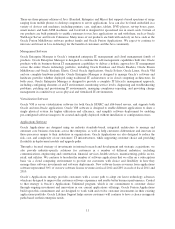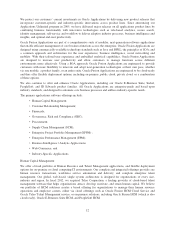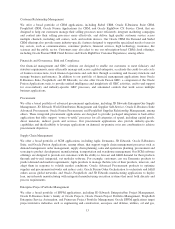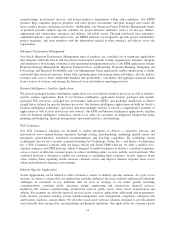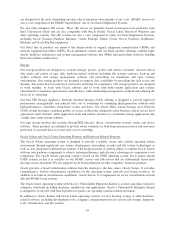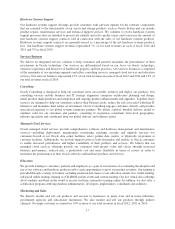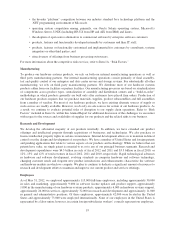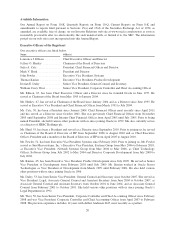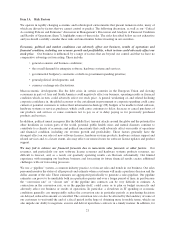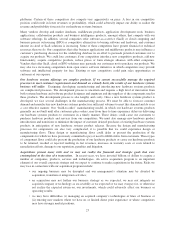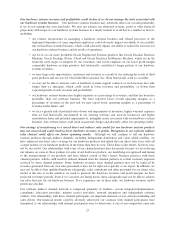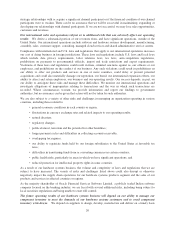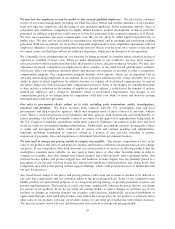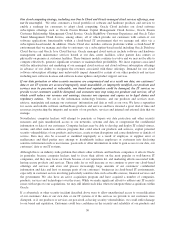Oracle 2012 Annual Report Download - page 25
Download and view the complete annual report
Please find page 25 of the 2012 Oracle annual report below. You can navigate through the pages in the report by either clicking on the pages listed below, or by using the keyword search tool below to find specific information within the annual report.Item 1A. Risk Factors
We operate in rapidly changing economic and technological environments that present numerous risks, many of
which are driven by factors that we cannot control or predict. The following discussion, as well as our “Critical
Accounting Policies and Estimates” discussion in Management’s Discussion and Analysis of Financial Condition
and Results of Operations (Item 7), highlights some of these risks. The risks described below are not exhaustive
and you should carefully consider these risks and uncertainties before investing in our securities.
Economic, political and market conditions can adversely affect our business, results of operations and
financial condition, including our revenue growth and profitability, which in turn could adversely affect our
stock price. Our business is influenced by a range of factors that are beyond our control and that we have no
comparative advantage in forecasting. These include:
• general economic and business conditions;
• the overall demand for enterprise software, hardware systems and services;
• governmental budgetary constraints or shifts in government spending priorities;
• general political developments; and
• currency exchange rate fluctuations.
Macroeconomic developments like the debt crisis in certain countries in the European Union and slowing
economies in parts of Asia and South America could negatively affect our business, operating results or financial
condition which, in turn, could adversely affect our stock price. A general weakening of, and related declining
corporate confidence in, the global economy or the curtailment in government or corporate spending could cause
current or potential customers to reduce their information technology (IT) budgets or be unable to fund software,
hardware systems or services purchases, which could cause customers to delay, decrease or cancel purchases of
our products and services or cause customers not to pay us or to delay paying us for previously purchased
products and services.
In addition, political unrest in regions like the Middle East, terrorist attacks around the globe and the potential for
other hostilities in various parts of the world, potential public health crises and natural disasters continue to
contribute to a climate of economic and political uncertainty that could adversely affect our results of operations
and financial condition, including our revenue growth and profitability. These factors generally have the
strongest effect on our sales of new software licenses, hardware systems products, hardware systems support and
related services and, to a lesser extent, also may affect our renewal rates for software license updates and product
support.
We may fail to achieve our financial forecasts due to inaccurate sales forecasts or other factors. Our
revenues, and particularly our new software license revenues and hardware systems products revenues, are
difficult to forecast, and, as a result, our quarterly operating results can fluctuate substantially. Our limited
experience with managing our hardware business and forecasting its future financial results creates additional
challenges with our forecasting processes.
We use a “pipeline” system, a common industry practice, to forecast sales and trends in our business. Our sales
personnel monitor the status of all proposals and estimate when a customer will make a purchase decision and the
dollar amount of the sale. These estimates are aggregated periodically to generate a sales pipeline. Our pipeline
estimates can prove to be unreliable both in a particular quarter and over a longer period of time, in part because
the “conversion rate” or “closure rate” of the pipeline into contracts can be very difficult to estimate. A
contraction in the conversion rate, or in the pipeline itself, could cause us to plan or budget incorrectly and
adversely affect our business or results of operations. In particular, a slowdown in IT spending or economic
conditions generally can unexpectedly reduce the conversion rate in particular periods as purchasing decisions
are delayed, reduced in amount or cancelled. The conversion rate can also be affected by the tendency of some of
our customers to wait until the end of a fiscal period in the hope of obtaining more favorable terms, which can
also impede our ability to negotiate, execute and deliver upon these contracts in a timely manner. In addition, for
21


